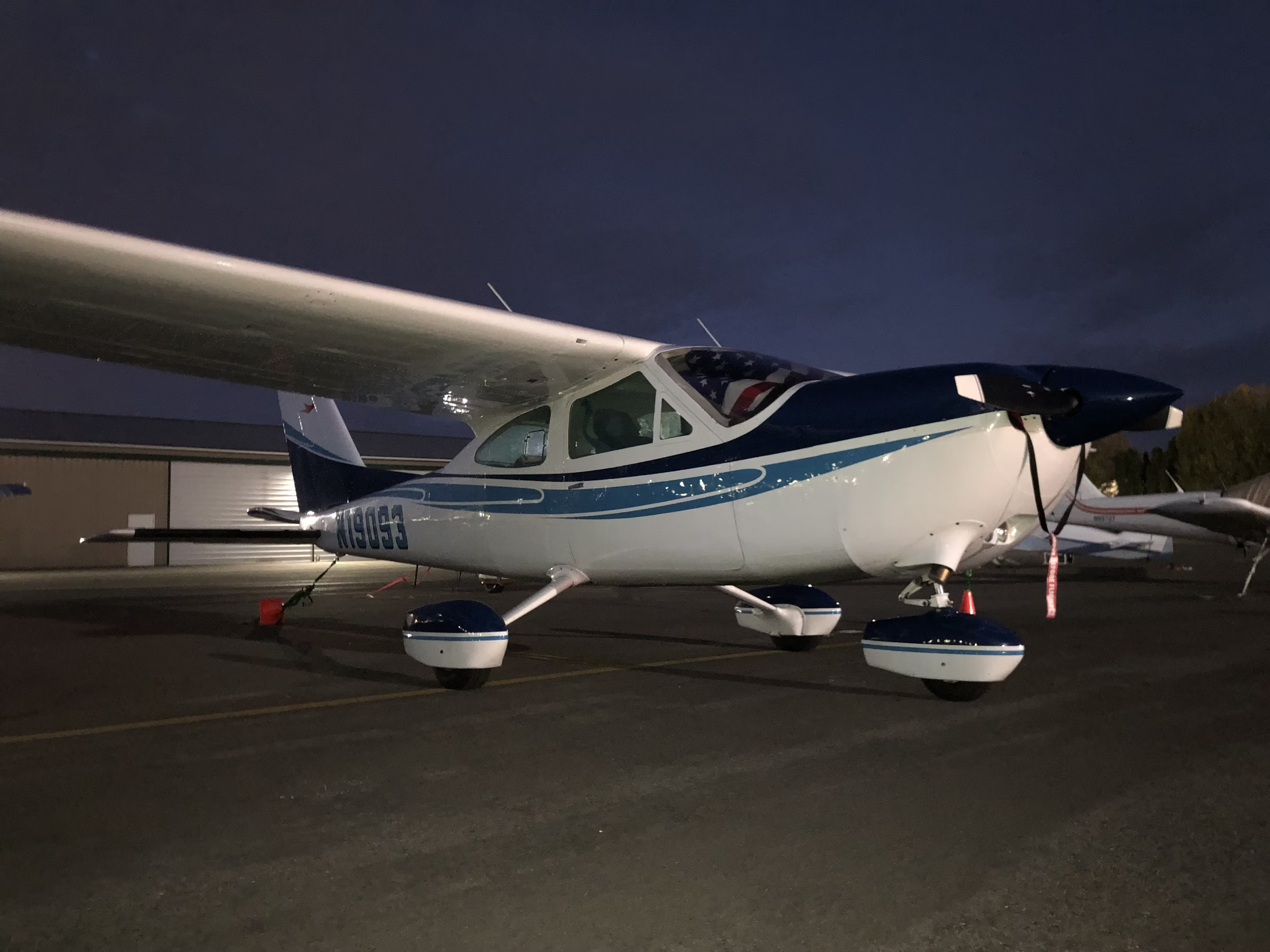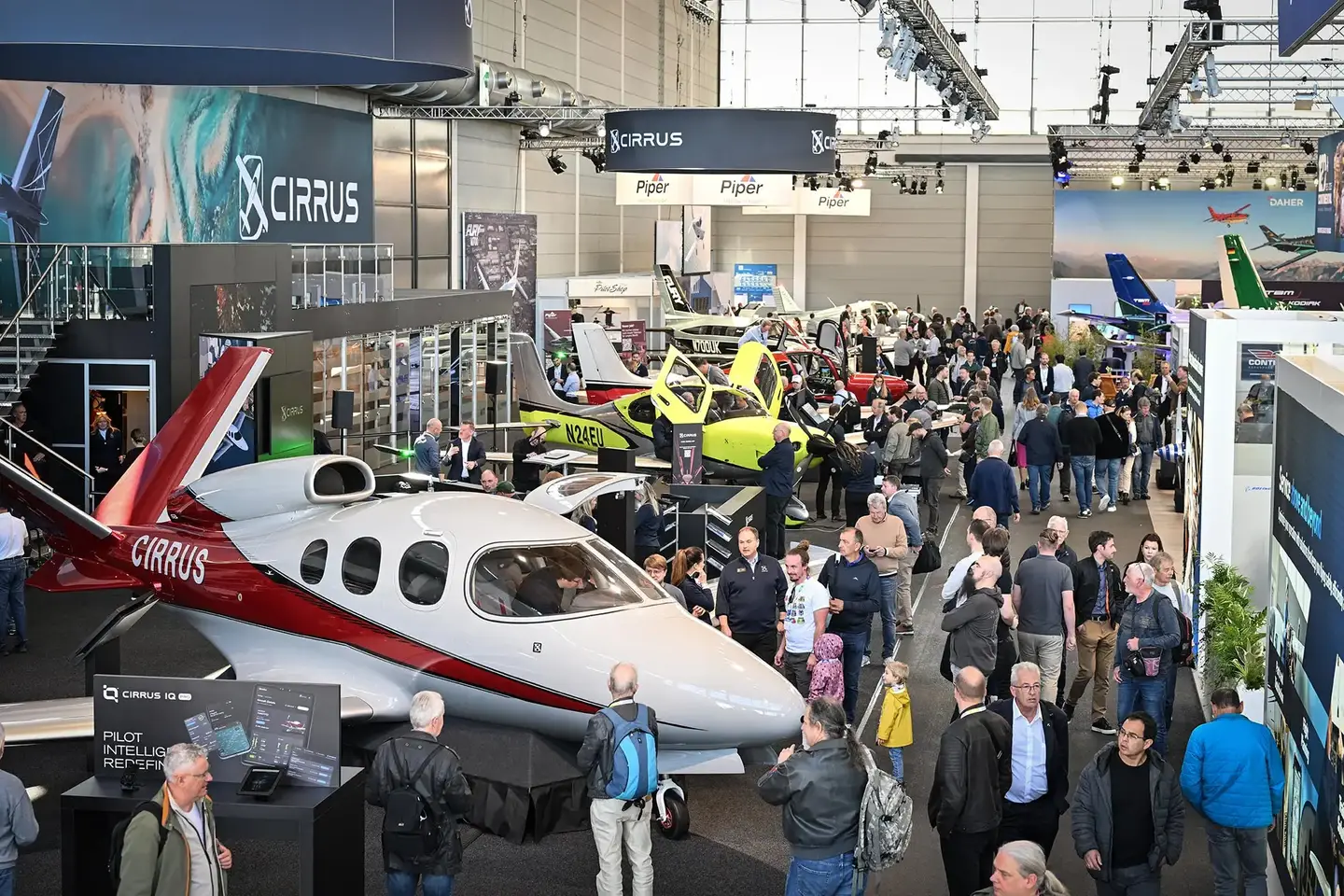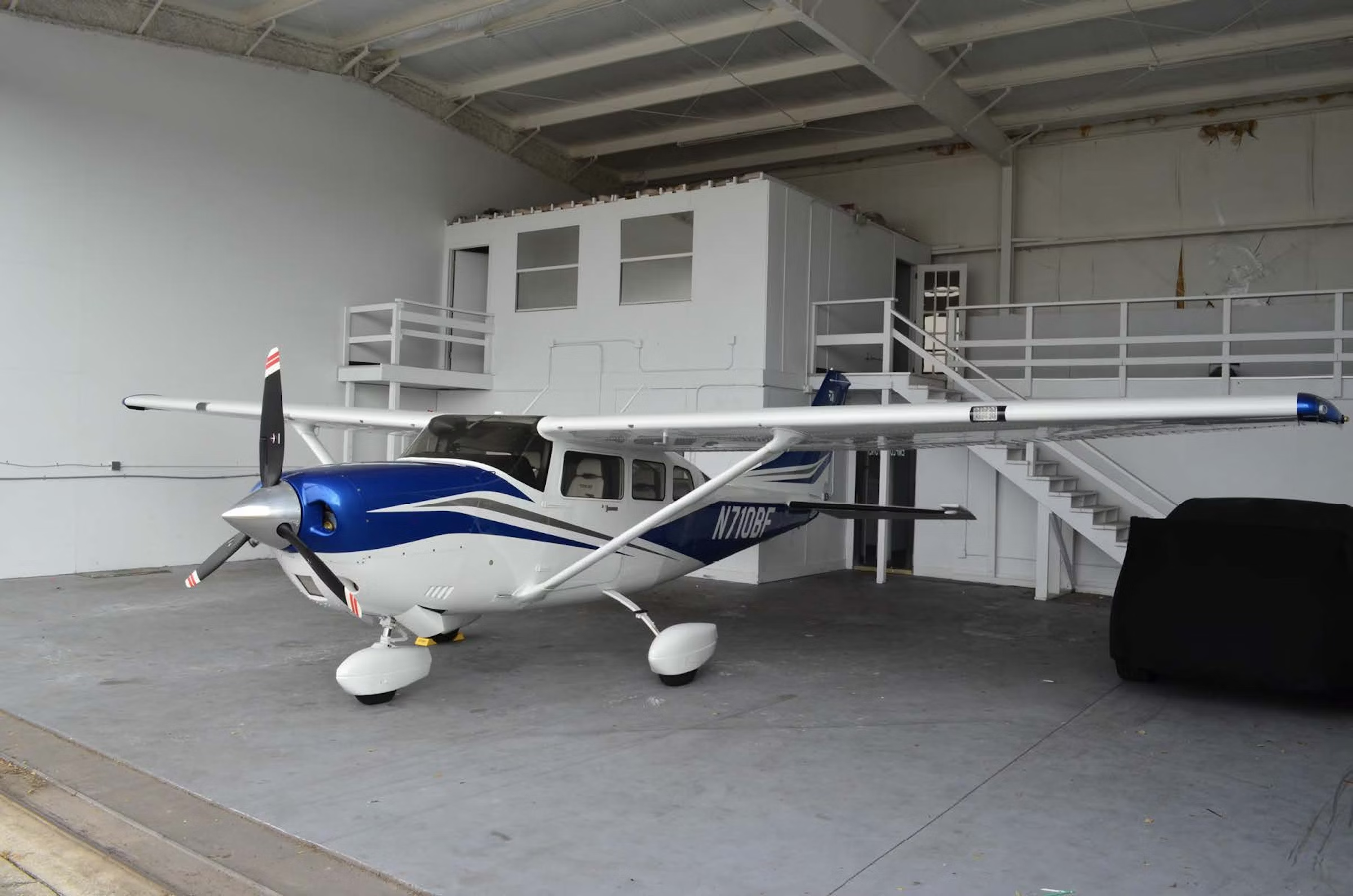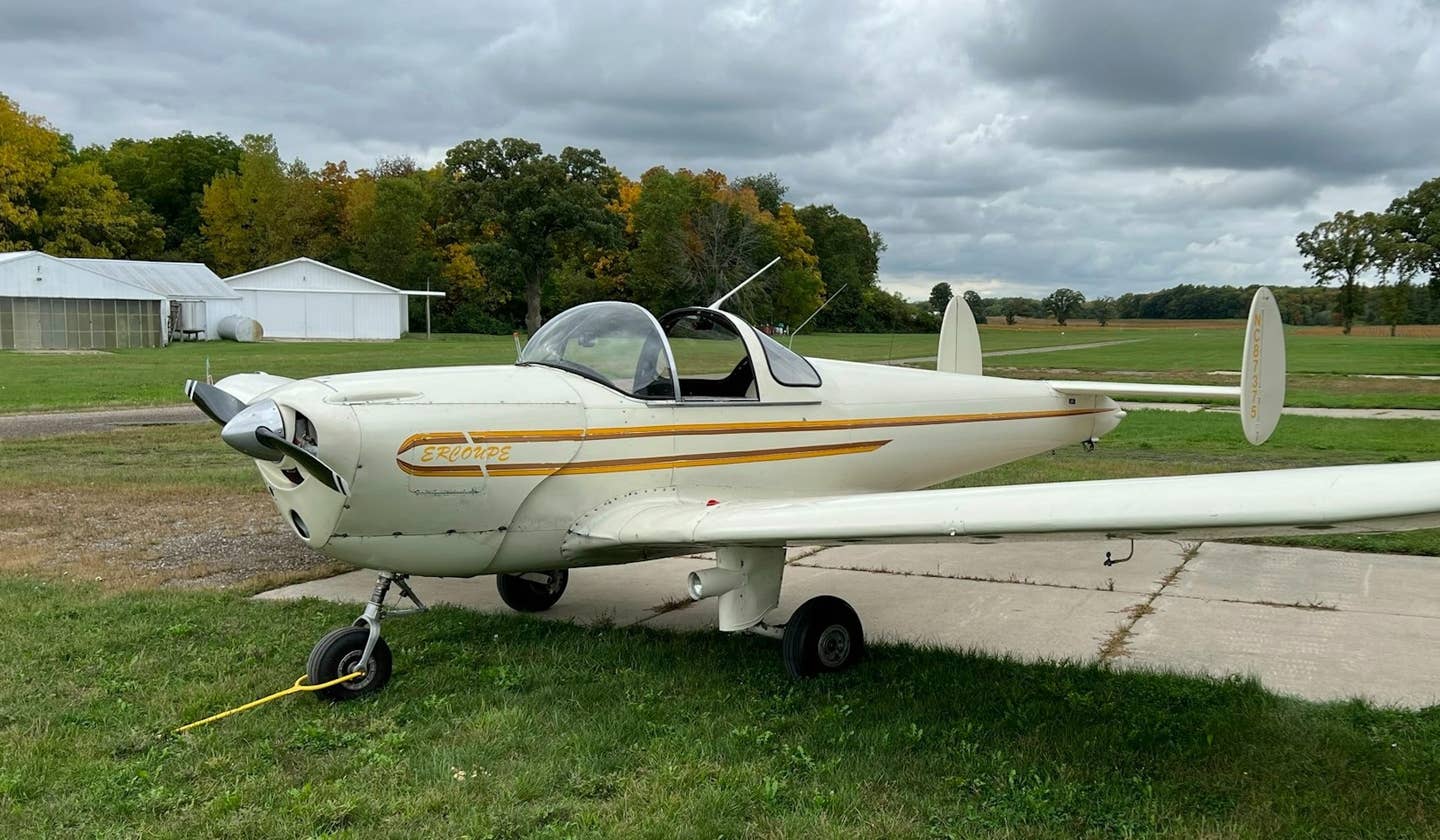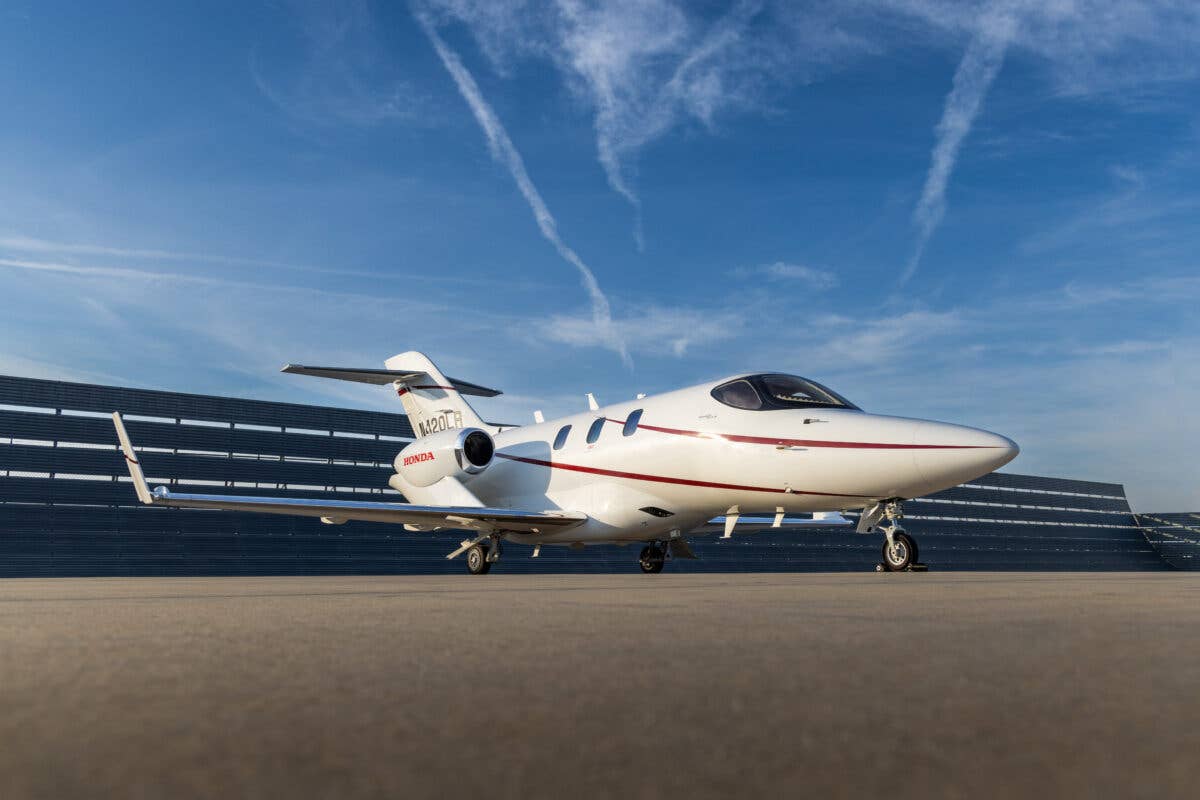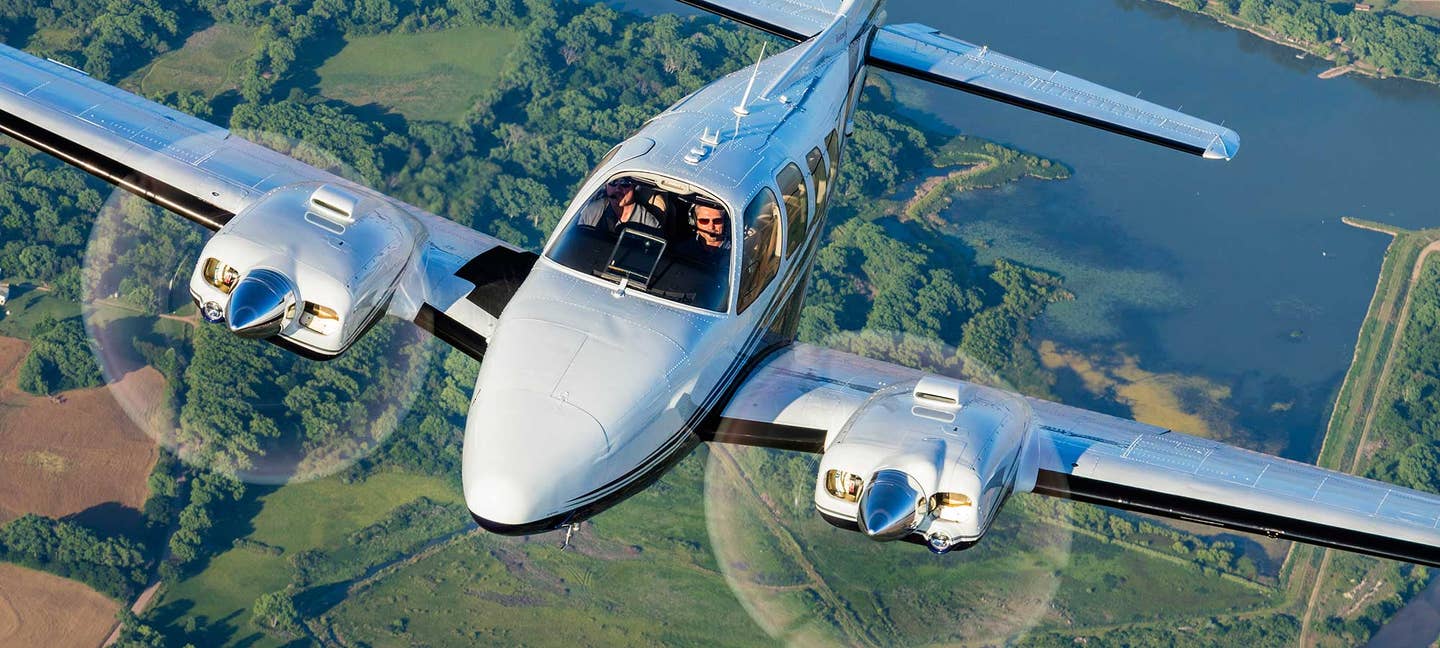
Some pilots believe a great aircraft, like a fine wine, only improves with age. Others turn up their nose at the thought of flying an airplane based on a decades-old design. Passing up a Beechcraft Baron G58 simply because the first Baron flew in 1962 would be a major mistake. The G58 is definitely not your grandfather’s Baron.
Aficionados are quick to point out that the 1969 Model 58 was no more than a Model 36 Bonanza fuselage mated to a Model 55 Baron wing and two 285 hp engines (the 55 had only 260 hp). But the new configuration morphed the Baron from a four- to five-seater to a six-seater with club seating. The airplane could carry more and fly farther than the Bonanza, and provided that second engine for additional safety. The first 58 weighed 5,400 pounds. The G58 I flew on a warm summer afternoon in Wichita, Kansas, maxed out at 5,524 pounds, a very modest weight gain over 50 years.
Beechcraft also built a pressurized and a turbocharged Model 58, neither of which are still in production. Only the normally aspirated G58 is available today. Textron Aviation, which owns Beechcraft, says 2,485 normally aspirated Model 58s have been built since 1969, with another 646 airframes split between the turbocharged and the pressurized models. At its peak in 1975, Beechcraft built 155 Model 58s. That annual number has declined to just 20 in 2016 and 13 in the first three quarters of 2017.
Beechcraft Baron G58 at a Glance
The New Baron
The Model 58 Baron I flew years ago was an airplane in a hurry to go somewhere. The latest G58 hasn’t lost an ounce of the get-up-and-go. Over the years, the G58’s power increased only slightly from the original Continental IO-520-C producing 285 hp a side to the Continental 300 hp IO-550-Cs spinning a pair of McCauley three-blade metal propellers today. On takeoff, Baron performance is impressive, with a maximum rate of climb near a jetlike 1,700 fpm.
Using maximum power, the G58 can scoot at speeds of up to 202 knots while comfortably seating six people. With four people aboard, cruising at max speed, the G58 covers just over 800 nm with reserves, while economy cruise can stretch that to nearly 1,500 nm. Maximum fuel capacity is 194 gallons, and baggage capacity hovers at 28 cubic feet or 420 pounds. Under standard conditions, the G58 demands 2,345 feet for takeoff and about 2,500 feet for landing.
The secret to why the Baron still matters in a world where light twins are a rarity is its sophisticated cockpit and rock-solid handling qualities. The G58 I flew left the assembly line with the newest Garmin G1000 NXi avionics system, a cutting-edge suite sure to make any pilot forget they’re not in the left seat of a pure jet (the “G” in G58, by the way, is for Garmin).
The NXi comes to life faster than the original G1000, with much improved graphics resolution. While the knobology is pretty much the same as the original, NXi offers optional wireless flight plan and database loading from a tablet, with improved joystick maneuvering for faster panning on the MFD. On the communications side, Garmin answered an age-old question during a frequency change by identifying who is on the other side. Set 126.7 on the radio and the NXi confirms you’re tuned to Wichita Approach.
The NXi offers sophisticated IFR and VFR chart options, including a night mode for improved readability in a darkened cockpit. The optional Surface Watch safety ensures a taxiing pilot doesn’t wander onto a runway by triggering an aural and a visual warning to prevent an incursion. New to NXi is a visual-approach option offering graphical guidance to any airport, even those without an instrument approach. Of course, a new G58 with synthetic vision is completely ADS-B In and Out compliant to meet the 2020 deadline.

Solid Frequent Training is Important
Effective training in a multiengine airplane is a must for any pilot, especially a guy like me who hasn’t flown a piston-powered twin in years. My Textron instructor, Will Klein, detailed Beechcraft’s Familiarization of Training Agreement, “consisting of four days of ground school and flight familiarization conducted in the purchaser’s aircraft.” Sixteen hours on the ground acquaints the pilot with the G58’s systems and flight characteristics, with eight hours in flight to bring the new owner up to speed.
Not on the Baron checkout through Textron is simulator time, because the company does not operate one in Wichita, although FlightSafety International does. The FSI Baron flight-training device is equipped exactly the way a new G58 comes off the line, with a Garmin G1000 panel and autopilot. FlightSafety’s G58 course demands 49 hours split between classroom and simulator training, with 12 hours in the FTD. FlightSafety does not train in the actual aircraft, however.
Another training option is the Wichita-based American Bonanza Society, where Tom Turner runs the organization’s Air Safety Foundation. Created in 1967, ABS delivers seminars and in-aircraft training across the United States for owners of all models of the Beechcraft Baron and the Bonanza under the Beechcraft Pilot Proficiency Program (BPPP) label. Training assumes clients already understand the intricacies of the avionics.
Turner says ABS teaches pilots the Baron’s natural tendencies, like with one engine out, by focusing on the importance of blue line, the aircraft’s best single-engine rate-of-climb speed. “Putting the nose of the aircraft down to keep the aircraft flying is critical, as is holding a heading. On a hot day, it might take 5 miles of flying straight ahead to reach pattern altitude. As soon as you turn, the rate of climb decreases, so the best airport might be somewhere straight ahead.” Turner says the “most common Baron accident is a gear-up landing. Maybe the PIC forgot to lower the gear, or the gear might have inadvertently retracted once the aircraft was on the ground,” another reason they train pilots not to grab anything while the aircraft is still rolling out after landing.
A G58 Up Close
Climbing aboard N476BE took me back a few decades to when I first climbed into one at my Chicago Beechcraft workplace on DuPage Airport. I still remember the feel and the smell of the new leather in that Model 58. Construction inside and out indicated this airplane was created by craftsmen, using leather and almost no plastic. I knew on that first flight that the machine beneath me was a solid airplane. Seeing the G58 then was like being reunited with an old friend.
Climbing across the front seat from the only front entry door on the right once seemed awkward, but no longer. It’s simply the price of owning a Baron. Once settled in the left seat, I realized again the G58 fit me rather like a sports car ... almost. I’m short from waist up, so even when I’m sitting up straight, I usually need a cushion to better see across the panel. Unfortunately, I’d forgotten mine and the seat adjustment wasn’t enough, so Klein and the guys in the hangar substituted a pair of engine plugs. Yes, a little uncomfortable, but that wasn’t Textron’s fault. By the time we took off, I’d already forgotten about my bottom anyway.
Starting the G58 is a snap. Within just a few minutes of settling down in the cockpit, the two throaty-sounding Continentals were ticking over as the avionics finished coming up to speed. Best of all, with the engines running, we were able to turn on the air conditioning, an option Klein told me nearly every Baron buyer adds.
The trick when taxiing the G58 is to be sure the throttles are back at idle to avoid riding the brakes. As we taxied out to Runway 1R at KICT, the MFD made nearby traffic conspicuous with ADS-B ground targets outlined in brown and those airborne in white. Despite perfect weather, we entered a VFR flight plan to Ponca City, Oklahoma, about 60 flying miles south. All flight plans can easily be uploaded with either ForeFlight or Garmin Pilot.
Around 2,200 rpm during engine run-up, the props enter the governing range, and they reacted smartly when I cycled them, with a definite feel of resistance as control oil flowed and stabilized them at 2,000 rpm. Power back to 1,500 rpm for a propeller feather check and we were ready. Flaps were up and cowl flaps open for takeoff. We reviewed the takeoff numbers, noting blue line, as well as the slower red line, the slowest speed at which the pilot can expect to maintain directional control should an engine quit.
My first rolling takeoff reminded me about P-factor as the Baron zigged a bit. Once solidly in charge again, the Baron accelerated quickly as I held the proper amount of rudder this time. Near 85 knots, the elevator began to float, and shortly thereafter, we were airborne, quickly headed for the 130 knots climb speed we’d briefed. I held full power, but pulled the props back to 2,500 rpm to reduce the growl for the folks around the airport below.
Hand-flying to 7,500 feet, Klein showed me the ease of leaning the big Continentals. Simply pull the mixtures to the dynamic blue markers on the fuel flow and the job’s finished. We indicated about 800 fpm in the climb and 154 knots true airspeed. Passing 7,300 for 7,500, the altitude alerter strangely chimed. In the aircraft I normally fly, the chime sounds 1,000 feet before the selected altitude, but in the Baron, it’s 200.
Leveling at 7,500 feet, we accelerated and I closed the cowl flaps. Engine power read 23 inches of manifold pressure, with the props still holding 2,500 rpm. At this high power setting, the Baron gulped about 20 gallons a side while indicating 185 knots. Leaning got the flow back to 35 gallons per hour total.
Since straight and level flight is pretty boring, I tried a series of shallow and steep turns at various power settings. While there’s no boost on the flight controls, the Baron handles solidly, even when slow, like a much larger aircraft.
Running on One
I wanted to see how the Baron behaved on one motor at 7,500 feet. With Ponca City nearby just in case, I began pulling the left throttle back to simulate a failure. When the landing-gear horn began beeping, Klein suggested keeping the wings essentially level, the ball centered and the heading steady. As I brought up mixture and power on the asymmetrical, thrust became more pronounced, but nothing a little rudder trim couldn’t handle. I verified, then feathered the left propeller. On one, we tried an alternator test that proved even with all lights and heats on, we’d only taxed the remaining alternator to 70 percent.
There’s always a pause for me when I see a propeller feathered, but back to business. By then we were at 7,300 feet and 113 knots, with full power on the right engine. Once stabilized at 123 knots, I tried easing the nose up about a few degrees and the airplane began climbing while demanding additional right rudder, stabilizing at about 100 fpm and 101 knots. We leaned the right one back and the climb rate picked up a bit with those extra few horses as I made some very gentle turns. Each time I did, the climb rate pretty much stopped.
Because the Baron is equipped with unfeathering accumulators, restarting the left engine meant first moving the prop lever forward as the propeller began to slowly turn, before pulling it back again to the detent to allow the engine to warm up. The rise in CHT temperatures confirmed the engine was ready, and I matched the left and right props at 2,500 rpm and the throttles at 16 inches of manifold pressure.
There was so much more to my day with the G58, such as a number of coupled and hand-flown instrument approaches and a number of landings. Clearly the Baron’s proud heritage of craftsmanship in manufacturing, as well as its solid big-airplane handling reputation, lives on in this newest airplane capable of handling most of the short to midsize missions any owner-pilot might need.

Sign-up for newsletters & special offers!
Get the latest FLYING stories & special offers delivered directly to your inbox

